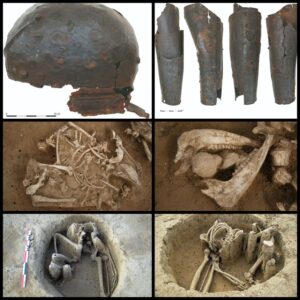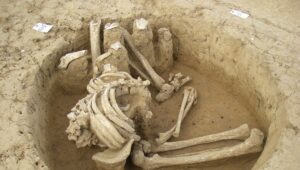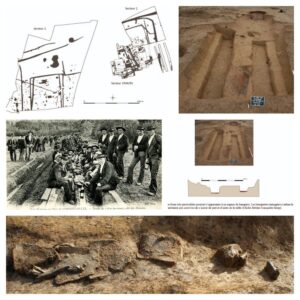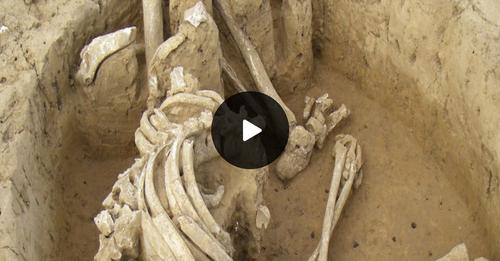Long invisible to archaeologists, Gallic sanctuaries were only discovered about thirty years ago. One of them, located in the Oise, has just been the subject of an archaeological dig. With François Malrain Researcher at Inrap.
Between Beauvais and Compiègne, at the top of a plateau overlooking the plain of Saint-Just-en-Chaussée (Oise), the Gauls built an astonishing sanctuary from the 4th century BC onwards to honor their gods.François Malrain “The sanctuary of Saint-Just-en-Chaussée is built on a high point in the landscape, on a remarkable height, on a plateau and its slopes, and in this way, it must have been visible from afar.

The unsolved mystery of the remains of a skeleton buried in a sitting position, found in the sanctuary of Saint-Just-en
We also know that t is installed in an already very wide open landscape, as revealed by charcoal analyses, among other things with the presence of alders and hazel trees which reveal both the presence of water and a very open landscape.

The unsolved mystery of the remains of a skeleton buried in a sitting position, found in the sanctuary of Saint-Just-en
It is also installed near a small river called the Arrée which flowed at the bottom of this sanctuary.
François Malrain “Before the discovery of this sanctuary, it was thought that the Gauls practiced their worship in the natural environment, near springs and rivers for example, or remarkable points of the landscape, such as rocks for example.
The Gournay excavation on Aronde will give a completely opposite image to what we thought until then, with real spaces dedicated to places of worship and the practice of Gallic religions.”

The unsolved mystery of the remains of a skeleton buried in a sitting position, found in the sanctuary of Saint-Just-en
Offerings displayedWithin the sanctuary, skulls of oxen and carcasses of horses were exposed and then often thrown into ditches.
Thus, in a ditch, were 48 bovine skulls, very altered following a long exposure to bad weather. In another ditch, vases and quarters of meat make up a veritable staging. Weapons are also very present. Among them, shields and their umbos (central part of the shield), helmets, even swords.
The most exceptional piece is an iron armour, dated from the 60s to 30s BC. All this furniture, broken, twisted or hammered, to better desacralize them, had, beforehand, to constitute real trophies.François Malrain “In an enclosure that is about 60 meters by 50 meters on a side, which is about the size of the other sanctuaries that we know, we discovered a lot of metal pieces, some of which appeared very enigmatic during the excavation. These pieces turned out to be completely unique pieces of armor for the moment in France.
They are thin sheets of metal that are less than two millimeters thick, hemmed so as not to hurt the skin.François Malrain “The armor covers the entire character. What is extraordinary about this site is that it is dated to the middle of the 1st century BC, globally, during the Gallic Wars.
We found also tubular pieces that cover the arm and forearm, as well as pieces that could cover the ankles and possibly the thighs as well, and thin hinged plates that could cover the trunk.” Individuals buried squatting would they have been sacrificed?Several human graves are present in the sanctuary: curiously, the individuals were buried in a seated position.
Many bones show traces of heating, cutting, but also traces of scavengers. Traces on the skulls of a pit evoke the opening of the cranial box and the removal of the face, which are reminiscent of the texts of Diodorus of Sicily and Strabo. If the buried individuals are probably Gauls, who are those whose bones have been mutilated and poly-fractured? Perhaps Romans, victims of some violent episodes of the Gallic war, Roman weapons having been found within the sanctuary.
Material found on the site (helmet and forearm protections) / environment: animal remains (dog and sheep) / Human remains of individuals buried seated. Material found on the site (helmet and forearm protections) / environment: animal remains (dog and sheep) / Human remains of individuals buried seated.François Malrain “Compared to the burial standards of the Latenian era, which was rather incineration, there we have seated buried.
They have been placed in small circular pits created to accommodate them, with slightly different sizes They have the right leg bent and the foot which is placed under the buttock while the left leg is bent against the wall of the pit.
There are eight of them. Overall, there are about fifty currently known in France and Switzerland […] So it’s an unusual practice, but we’re starting to spot it all over Gaul.” Banquet Pits One of the capital elements of this sanctuary are strange hollowed-out benches which could
